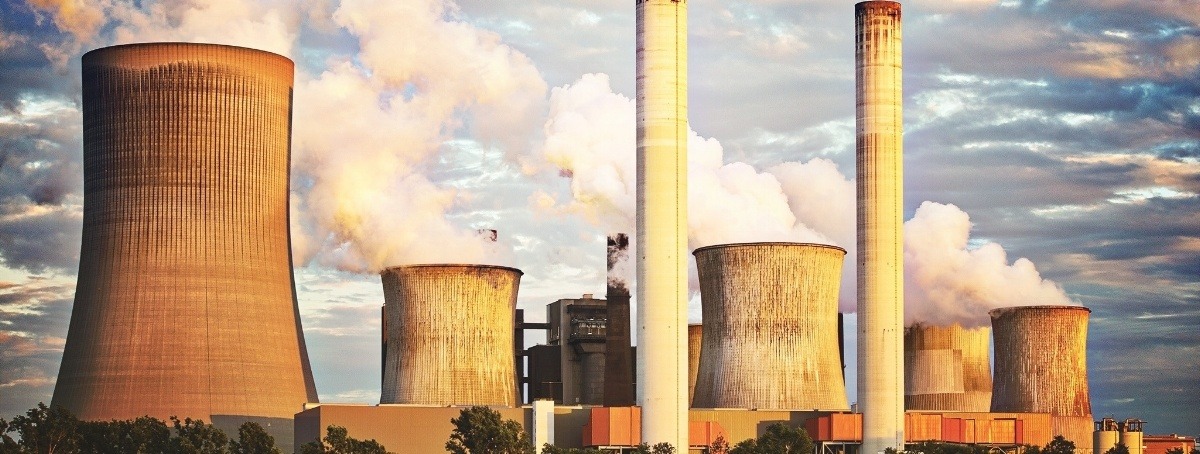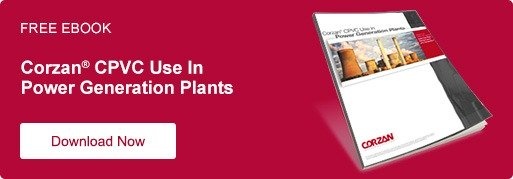Design for Pipe Stress in Power Plants
The hazardous caustic and corrosive chemicals and levels of heat and pressure involved in treating and moving large volumes of water in power plant operations make it incumbent upon system designers to choose from among the few materials for pipe, valves and fittings that can reliably stand up to these rigors. In plants from gas turbine combined cycle to nuclear to combined heat and power, one of the most reliable such materials is thermoplastic Corzan® CPVC.
Applications for CPVC piping used in power plants include:
- Underground cooling water loops
- Cooling tower risers and headers
- Demineralizing boiler feed systems
- Condensate return water systems
- Flue gas desulfurization systems
- Environmental systems for coal-fired steam plants
- Wastewater treatment facilities
In designing reliable piping systems for these applications, identifying points of pipe stress and how it will be mitigated is an important aspect of the due diligence process. However, for many years, the construction requirements for thermoplastic pipe and fittings associated with water as a working fluid in connection with boiler and pressure vessels were not adequately defined in existing industry standards such as ASME’s B31 series.
This was rectified in 2019 with the publication of ASME NM.1, Standard on Thermoplastic Piping Systems which, among other things, outlines limits for both sustained (longitudinal) and displacement (arising from temperature effects) pipe stress in thermoplastics.
However, the absence of defined best practices for plastic piping design for so long may be linked to one of the most common causes of pipe failures, reduced service life and/or higher than necessary maintenance and repair costs in the field. That cause: improperly locating and spacing pipe supports and failing to make allowances for thermal expansion and contraction in the engineering design of a system.
A thermoplastic system, for instance one constructed of Corzan Industrial Systems, differs by its very nature from metal and has unique design and construction requirements. Consider a fundamental difference – unlike metal, CPVC is capable of being repeatedly softened with increases in temperature and hardened with decreases in temperature. In other words, CPVC’s material properties vary greatly from those of metal, and planning the system to accommodate pipe stress has its own distinctive differences as well that ASME NM.1 addresses.
Some Considerations in Planning For Pipe Stress
Every piping system will have different stress point loads which should be mitigated, and there are many methods that can be utilized to address these loads. Operations may need to change how the medium is conveyed, pump and/or valve sequencing, or pump sizing to reduce system surges. Another option is analyzing how to distribute the load to minimize stress across fittings. Thermoplastic fittings are more rigid and thus less forgiving than the CPVC pipe, which is why designers must distribute the stress into the pipe and not the fittings.
Typical methods of distributing stress in thermoplastic systems are incorporated in the thermal expansion and contraction methodologies. Utilizing strategically placed and sized change of directions, expansion loops or offsets are very common. Adjustments to the support structure must take this into account. Animated renderings of each of these approaches can be viewed here.
Also, most plastics have a coefficient of thermal expansion that is significantly higher than those of metals. As temperature increases, modulus and tensile strength decrease. If a piping system has the potential to be subjected to a significant temperature change, the linear thermal expansion of the system when subjected to that temperature change must be taken into account when designing the system. If a run of pipe is constrained at both ends, an increase in temperature will cause the material to expand, resulting in compressive pipe stress. It should also be noted that linear expansion is independent of pipe size, and large diameter pipe is more rigid than small diameter pipe, so the larger the pipe size, the more length is needed over which to deflect.
Corzan Industrial Systems Resources and Tools
When this mounting force exceeds the material’s allowable stress, damage occurs to the piping system. Thus, compensation for thermal expansion should be included in the system design after computations using the Corzan CPVC Pipe Expansion Calculator, which facilitates accounting for linear expansion and designing around compression stress concerns. Inputting only the pipe size, maximum and minimum temperatures, and pipe run length, the calculator reveals both (1) the linear expansion and (2) the dimensions for loops that will be long enough to prevent the pipe from bending beyond its limits while preserving the natural, lateral movement of the pipe and fittings.
Here’s an example of a calculation for an expansion loop for a section of 3-inch Schedule 80 CPVC pipe 100 feet in length undergoing an 80°F temperature increase, compared to that for copper.

If you want to know more about selecting Corzan Industrial Systems for your next power generation project, download the e-book “Corzan CPVC Use in Power Generation Plants.”
And also know that every decision to work with Corzan Industrial Systems brings with it a commitment to offering dedicated support to ensure a smooth execution of the technology. Lubrizol Advanced Materials brings decades of industrial, plumbing and mechanical contracting experience in training and educating installers at the office or the jobsite. Likewise, project engineers can take advantage of our subject matter experts and ASPE-approved CEU course instructors – fulltime Lubrizol Advanced Materials employees who are industry experts and offer the most up-to-date training during every accredited session.


